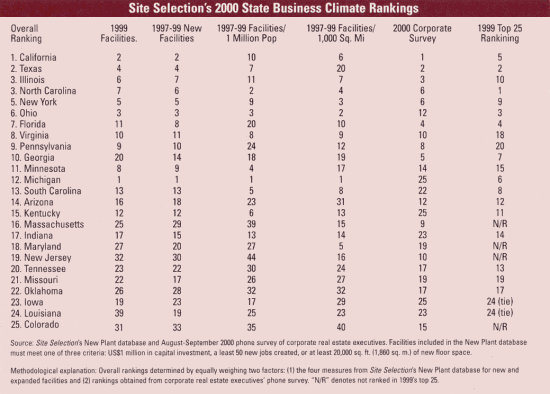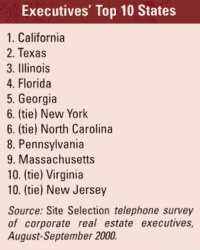It?s official, already: The glow is back on the Golden State?s business climate.
That?s the scoop from the top of Site Selection?s business climate rankings for 2000. California this year moved all the way up to No. 1 from 1999?s No. 5 finish.
The Golden State ranks as a perennial business location powerhouse, of course, as reflected by an economy that, alone, would rank as the world?s seventh largest. Over the last decade, though, the state?s business climate has weathered some tough sledding. A mid-1990s survey by the California Business Roundtable, for example, found that 80 percent of California-based CEOs felt that state regulations were hurting the business climate.
The times they have ?a changed. California?s No. 1 rank in Site Selection?s 2000 rankings marks only the latest evidence of the state?s resurgent business climate.
California, for example, finished No. 2 in the 1999 race for Site Selection?s Governor?s Cup, awarded to the U.S. state with the highest annual tally of new and expanded corporate facilities. California?s total of 2,137 new location projects was a microscopic 0.017 percent behind 1999 Governor?s Cup winner Michigan. And California practically lapped the field in last year?s battle for new manufacturing supremacy. The state?s 1999 total of 432 new manufacturing projects was an eye-popping 46 percent higher than Michigan?s No. 2 tally.
Perception, however, is often a lagging indicator when it comes to business climates. Images change slowly — both for the better and the worse. That?s why it?s more than a little significant that California was voted the No. 1 business climate in Site Selection?s poll of corporate executives, a critical element in our rankings methodology (see accompanying executives? top 10 chart).

CLICK TO ENLARGE [47 KB]
Southeast, Midwest Take 15 of Top 25
Despite California?s rise to No. 1, however, some things stayed much the same in 2000?s business climate rankings.
One unmistakable area of continuity was in the regional representation among Site Selection?s top 25. As in previous years, the Southeast and the Midwest captured an inordinate number of 2000?s top 25 states. Together, the two regions accounted for 15 of the top 25 spots.
The Southeast placed four states in 2000?s top 10: No. 3 North Carolina (in a tie with Illinois), No. 7 Florida, No. 8 Virginia and No. 10 Georgia. Joining those four in this year?s top 25 were Southeast cohorts South Carolina at No. 13, Kentucky at No. 15, Maryland at No. 18, Tennessee at No. 20 and Louisiana at No. 24.
In addition, 2000?s rankings lent a ?Go Midwest, young man? spin to Horace Greeley?s famous exhortation. No. 3 Illinois (in a tie with North Carolina) and No. 6 Ohio ranked in this year?s top 10 business climates. The U.S. heartland?s top 25 contingent included as well Minnesota at No. 11, Michigan at No. 12, Indiana at No. 17, Missouri at No. 21 and Iowa at No. 23.
The 2000 business climate rankings were also notable for one of the Northeast region?s strongest overall showings in recent years. New York at No. 5 and Pennsylvania at No. 9 cracked this year?s top 10, joined by fellow Northeasterners Massachusetts at No. 16 and New Jersey at No. 19.
Texas, another perennial power, led the Southwestern states? ranks, finishing No. 2 overall — and No. 2 in the corporate executives? poll. Arizona at No. 14 and Oklahoma at No. 22 were the other Southwest states that graded in the top 25.
Coincidentally, the top 25?s twin outer limits comprised the lone top 25 representatives from two geographic regions: No. 1 California was the sole Pacific representative, while No. 25 Colorado was the only Rocky Mountain state.
Methodology Levels Playing Field,
Promotes Parity Between Large and Small
Geographic diffusion is clear in that regional breakdown for 2000?s top 25 states. While some regions scored exceedingly well, none, it seems, has a lock on the formula for building a better business climates.
Parity, however, has always been an integral element in Site Selection?s annual rankings. Consciously weighted to level the playing field, our rankings methodology incorporates results, perception and time.
Results and time come into play in the four ranking criteria drawn from Site Selection?s New Plant database, the industry?s most comprehensive storehouse of business location information. Those four criteria, as applied in 2000?s rankings, include:
- total new and expanded facilities in Site Selection?s annual tally for 1999;
- total new and expanded facilities for the period covering 1997 through 1999;
- total new and expanded facilities per 1 million residents for the period covering 1997 through 1999; and
- total new and expanded facilities per 1,000 sq. miles (2,600 sq. km.) for the period covering 1997 through 1999.
Those indices — which, it bears repeating, are based on actual business location data — provide Site Selection?s rankings methodology with a vital foundation that?s rooted in results. Unlike many other business climate ranking systems, ours is not a popularity contest based on criteria that hypothetically suggest where businesses might locate. Instead, much of our rankings derive from where businesses actually are locating.
In addition, the rankings? per-population and per-area indicators ensure that the sheer size of some states doesn?t automatically ensure high rankings.
The time element in our methodology comes into play in the three ratings indicators based on three-year tallies. Those three-year criteria put a premium on continued success in business attraction, de-emphasizing ?one-year wonders.?
Together, those four criteria from the New Plant database make up 50 percent of the overall rankings.
The fifth rankings criterion — which makes up the other 50 percent of the overall rankings — comes from Site Selection?s annual survey of corporate real estate executives. Those surveyed executives work for firms with nationwide operations, ensuring a broad experiential base on which to make assessments.
Specifically, executives were queried by phone to answer this question: ?Based on your experience, what are the top 10 state business climates, taking into consideration such factors as lack of red tape, financial assistance and government officials? cooperation??
The 50 percent weighting accorded the corporate executives? survey acknowledges the critical role that perception invariably plays in assessing business climates. In this day and age, rightly or wrongly, perception to great extent becomes reality.

Executives? Rankings Fuel
Some State?s Upsurges
That methodology in part explains some states? rankings upsurge in 2000.
Illinois, for example, this year moved all the way up to No. 3 from 1999?s No. 10 slot. In addition to having a solid set of rankings from the four indicators derived from Site Selection?s database, Illinois ranked No. 3 in the collective results of the corporate executives? business climate voting.
Strong showings in the executives? poll also helped two Northeast states make major moves up in the 2000 hierarchy. New York ascended to No. 5 after 1999?s No. 9 finish, while Pennsylvania jumped all the way up to No. 9 from 1999?s No. 20 slot. New York ranked No. 6 in the executives? poll (tied with North Carolina), while Pennsylvania ranked No. 8.
Also registering notable upward mobility in 2000?s rankings were No. 8 Virginia, which rose from 1999?s No. 18 slot, and No. 11 Minnesota, which finished at No. 15 in 1999.
Site Selection?s 2000 rankings also include four state business climates that were unranked in 1999?s top 25 pecking order: No. 16 Massachusetts, No. 18 Maryland, No. 19 New Jersey and No. 25 Colorado. Massachusetts and New Jersey both got particularly strong rankings shots in the arm from the executives? voting. Executives collectively ranked Massachusetts? business climate No. 9, and they ranked New Jersey?s No. 10.





